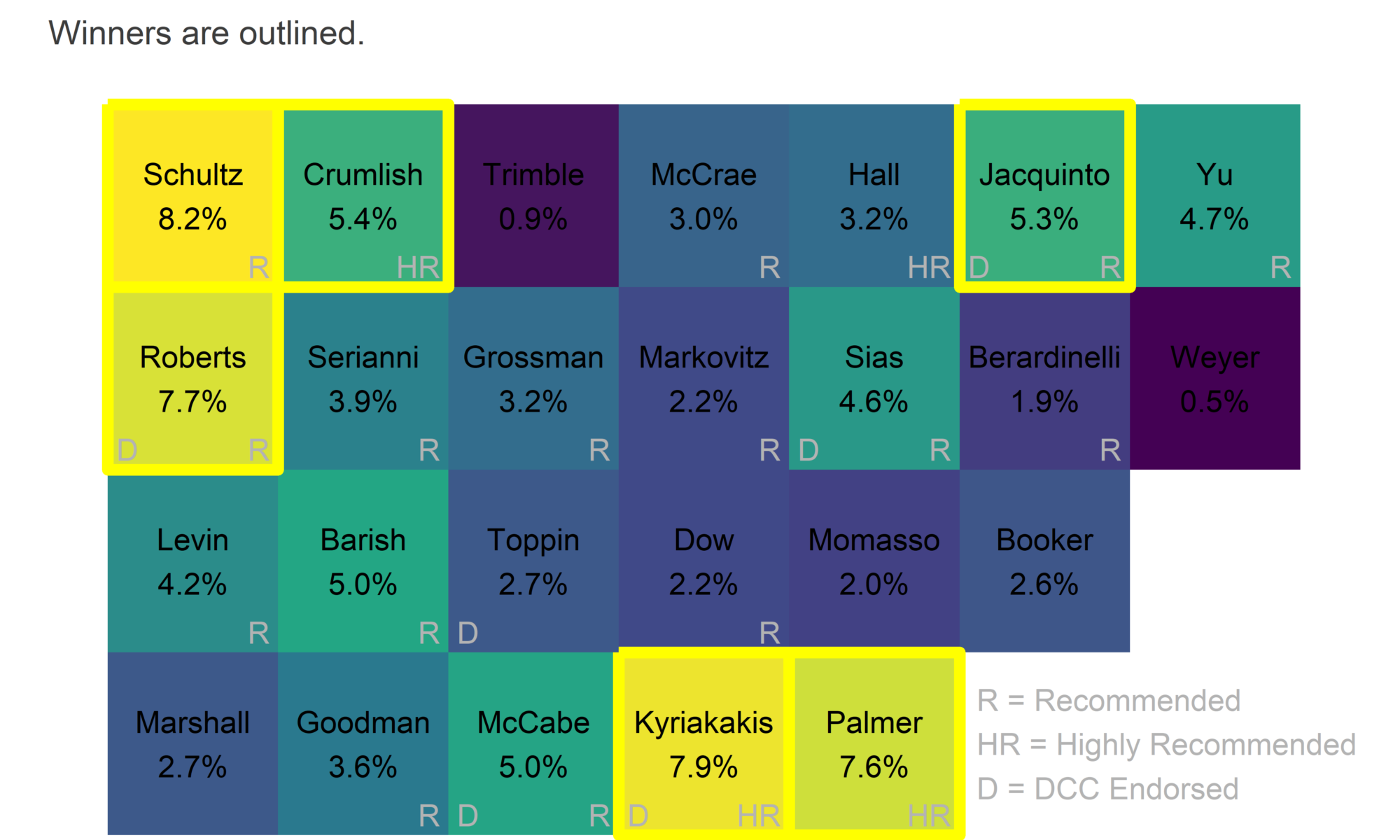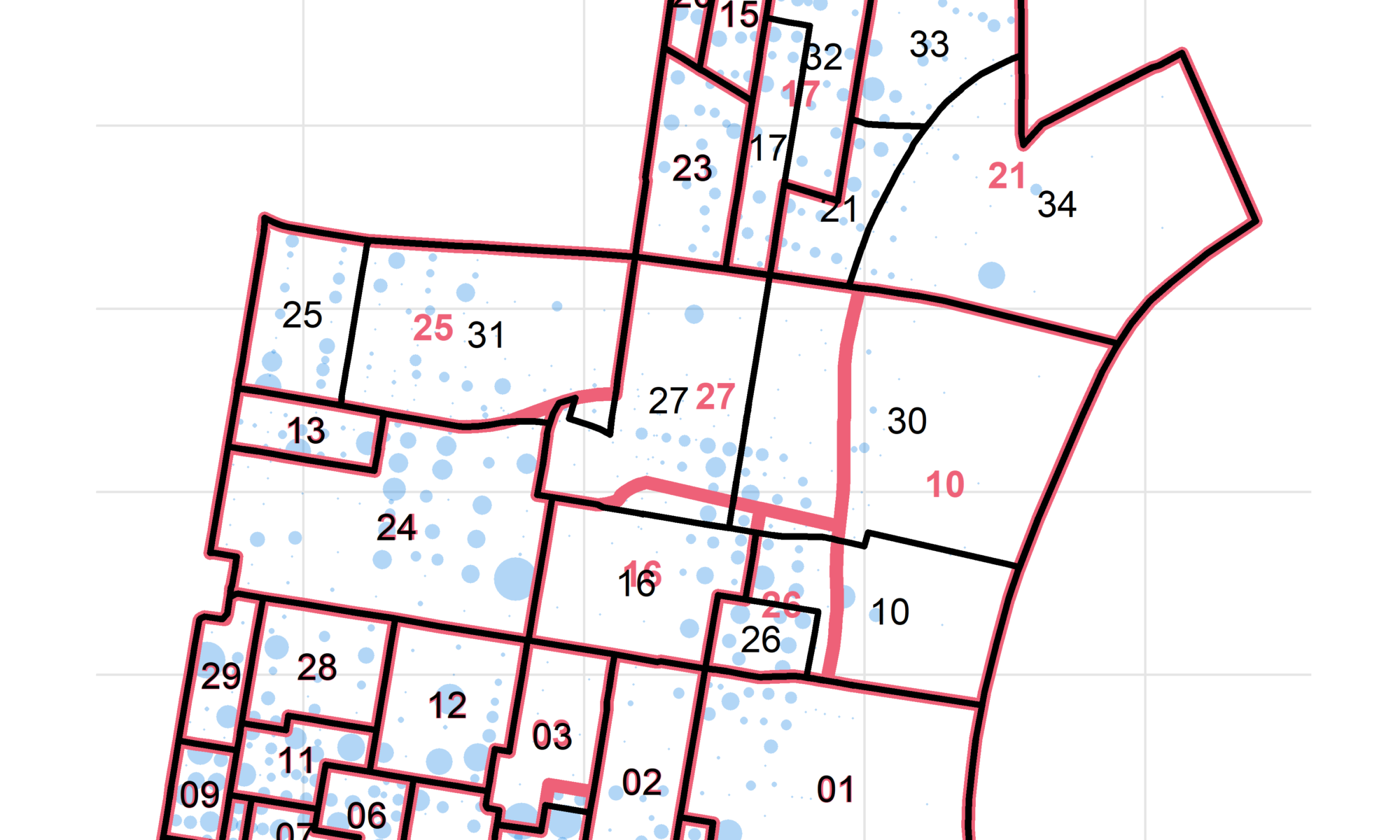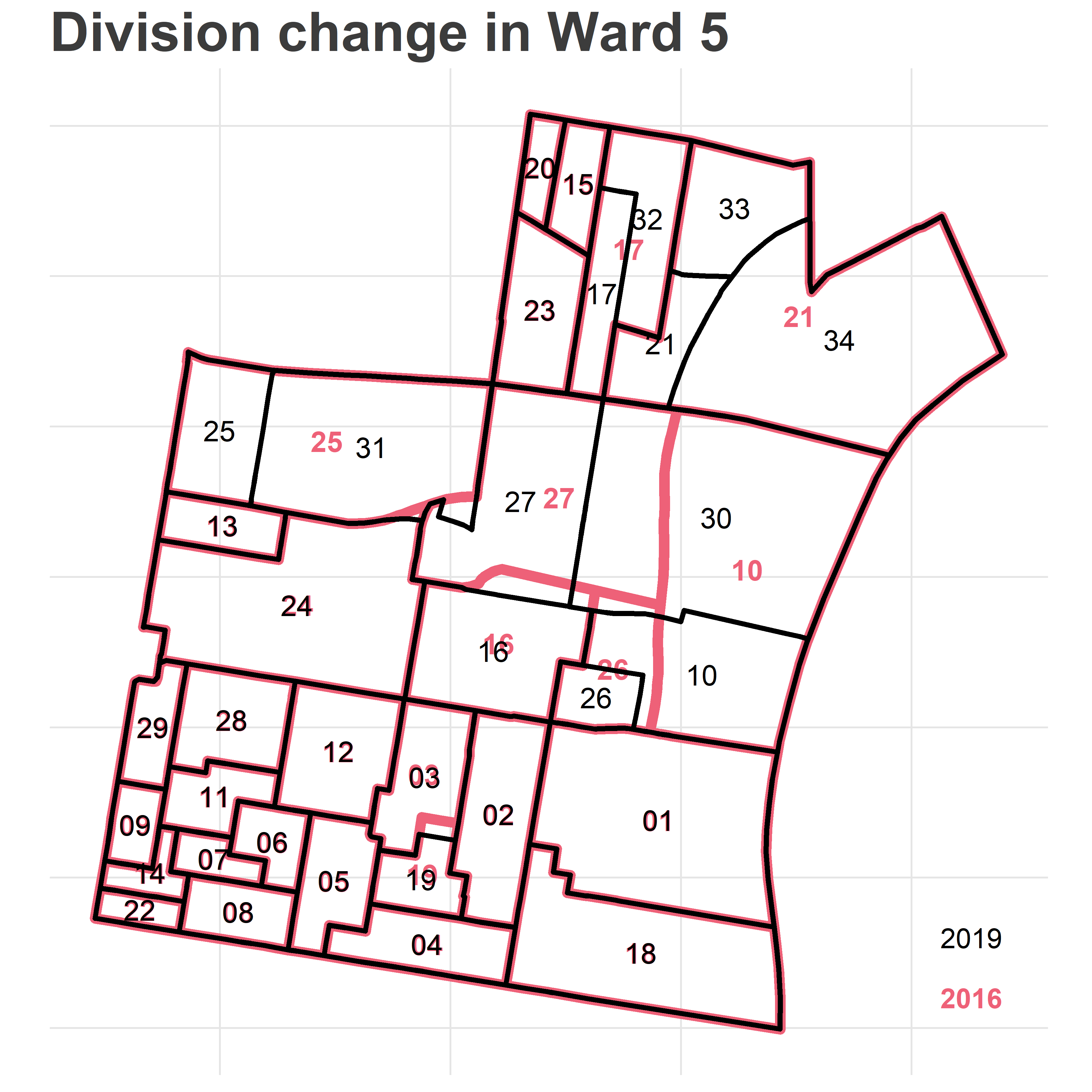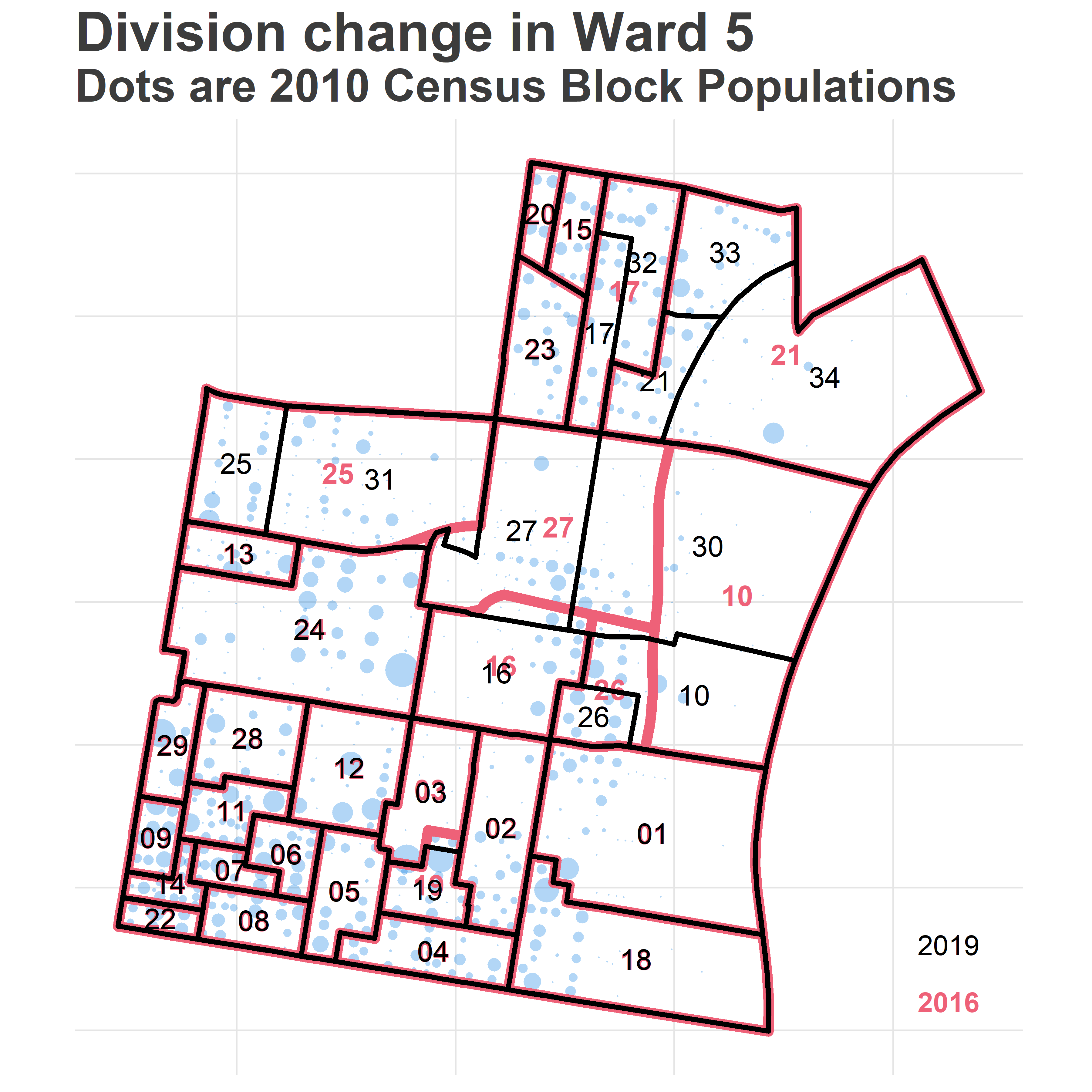Ahead of May 21st, I made some predictions about the Court of Common Pleas. I predicted a 66% chance that all six winners would be Recommended by the Bar; they all were. I predicted that 2.5 candidates would win from the first column and 1.0 from the second; those columns produced 2 and 1 winners, respectively.
But I’m here today to talk about something I got very, very wrong. Here’s something I wrote:
We get no Highly Recommended winners in 46% of simulations, and only one in another 47%. […] Getting two [Highly Recommended] winners (let alone three or four) would be a huge achievement, and presumably good for the citizens of Philadelphia, too.
Well, three Highly Recommended candidates won. I was pretty sure that wouldn’t happen, I gave it a 7% chance. To be fair, things with 7% chances happen all the time, but I actually think something changed this election. The Bar’s High Recommendations flexed their muscle.
Who won, and where
Looking at the layout of the ballot, you can tell yourself an easy story about how most candidates won.
View code
library(tidyverse)
df <- read_delim(
paste0("../election_night_needle/raw_data/PRECINCT_2019525_H08_M09_S54.txt"),
delim = "@"
) %>%
rename(
OFFICE = `Office_Prop Name`,
candidate = Tape_Text,
warddiv = Precinct_Name
)
df <- df[-(nrow(df) - 0:1),]
df <- df %>% group_by(warddiv) %>%
filter(sum(Vote_Count) > 0) %>%
group_by()
df_cp <- df %>% filter(OFFICE == "JUDGE OF THE COURT OF COMMON PLEAS-DEM")View code
format_name <- function(x){
x <- tolower(x)
x <- gsub("\\b([a-z])([a-z]*)", "\\U\\1\\L\\2", x, perl=TRUE)
x <- gsub("\\bMc([a-z])", "Mc\\U\\1", x, perl=TRUE)
return(x)
}
ballot <- read_csv("../../data/common_pleas/judicial_ballot_position.csv") %>%
mutate(lastname = gsub(".* ([A-Za-z]+)$", "\\1", name) %>% format_name())
df_cp <- df_cp %>%
filter(candidate != "Write In") %>%
mutate(
candidate = format_name(candidate),
Last_Name=format_name(Last_Name),
First_Name=format_name(First_Name)
)
ballot <- ballot %>%
filter(year == 2019) %>%
left_join(
df_cp %>% select(candidate, Last_Name) %>% unique,
by = c("lastname" = "Last_Name")
)
cp_overall <- df_cp %>%
group_by(Last_Name, First_Name) %>%
summarise(VOTES = sum(Vote_Count)) %>%
group_by() %>%
mutate(
winner=rank(desc(VOTES)) <= 6,
pvote = VOTES / sum(VOTES),
lastname=Last_Name
)
cp_overall <- cp_overall %>% left_join(ballot %>% filter(year == 2019))
ggplot(
cp_overall %>% arrange(VOTES),
aes(y=rownumber, x=colnumber)
) +
geom_tile(
aes(fill=pvote*100, color=winner),
size=2
) +
geom_text(
aes(
label = ifelse(philacommrec==1, "R", ifelse(philacommrec==2,"HR","")),
x=colnumber+0.45,
y=rownumber+0.45
),
color="grey70",
hjust=1, vjust=0
) +
geom_text(
aes(
label = ifelse(dcc==1, "D", ""),
x=colnumber-0.45,
y=rownumber+0.45
),
color="grey70",
hjust=0, vjust=0
) +
geom_text(
aes(label = sprintf("%s\n%0.1f%%", lastname, 100*pvote)),
color="black"
# fontface="bold"
) +
scale_y_reverse(NULL) +
scale_x_continuous(NULL)+
scale_fill_viridis_c(guide=FALSE) +
scale_color_manual(values=c(`FALSE`=NA, `TRUE`="yellow"), guide=FALSE) +
annotate(
"text",
label="R = Recommended\nHR = Highly Recommended\nD = DCC Endorsed",
x = 5.6,
y = 4,
hjust=0,
color="grey70"
) +
theme_sixtysix() %+replace%
theme(
panel.grid.major=element_blank(),
axis.text=element_blank()
) +
ggtitle(
"2019 Common Pleas Results",
"Winners are outlined."
)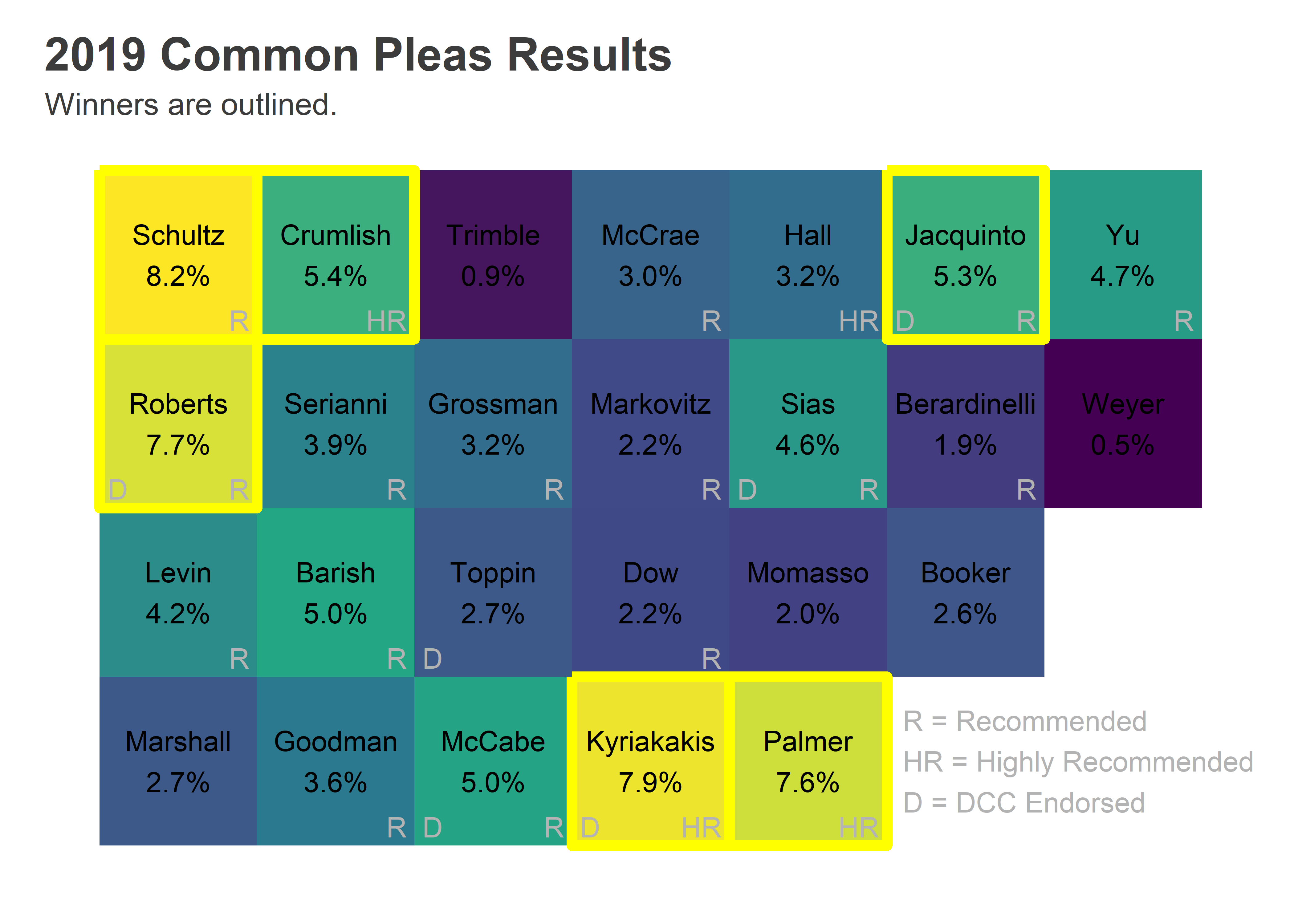
Jennifer Schultz won with number one ballot position and a Bar Recommendation. Joshua Roberts combined the first column with a Bar Rec and a Democratic City Committee endorsement. Crumlish had the top of the second column plus a High Recommendation. Kyriakakis and Jacquinto combined Bar Recommendations with DCC endorsements.
The person who my model thought absolutely, positively would not win was Tiffany Palmer. And she romped by 2.6 points.
When I published my predictions, I didn’t share the candidate-level results. That’s because my model only used structural factors, and knew nothing about candidates themselves. It would perform well at overall counts, while looking pretty silly for individual candidates. It knew, for example, that some candidates would be breakaway stars from the third column or later, but spread that probability among all of them.
Well, let’s go back and look under the hood at the candidate predictions themselves.
View code
cp_sim <- read.csv("../simulating_cp/simdf.csv")
cp_overall <- cp_overall %>% left_join(cp_sim %>% mutate(name=format_name(name)))
cp_overall <- cp_overall %>% arrange(desc(mean_pvote)) %>%
mutate(name=factor(name, levels=name))
ggplot(
cp_overall,
aes(x=name, y=100*mean_pvote)
) +
geom_point() +
geom_errorbar(
aes(ymin=100*pvote_05, ymax=100*pvote_95),
width=0
) +
geom_point(aes(y=100*pvote), color=strong_purple, size=2) +
theme_sixtysix() %+replace%
theme(axis.text.x = element_text(angle=-90, hjust=0)) +
scale_x_discrete(NULL) +
scale_y_continuous("Percent of Vote") +
expand_limits(y=0) +
ggtitle("Simulated and actual Common Pleas results") +
annotate("point", x = 15, y = 12, size=2, color=strong_purple) +
annotate("text", x = 15.4, y = 12, size=4, color=strong_purple, hjust=0, label="Actual Results", fontface="bold") +
annotate("point", x = 15, y = 14) +
annotate("errorbar", x = 15, ymin = 13.5, ymax=14.5, width=0) +
annotate("text", x = 15.4, y = 14, size=4, hjust=0, label="Simulated 90% Credible Interval", fontface="bold")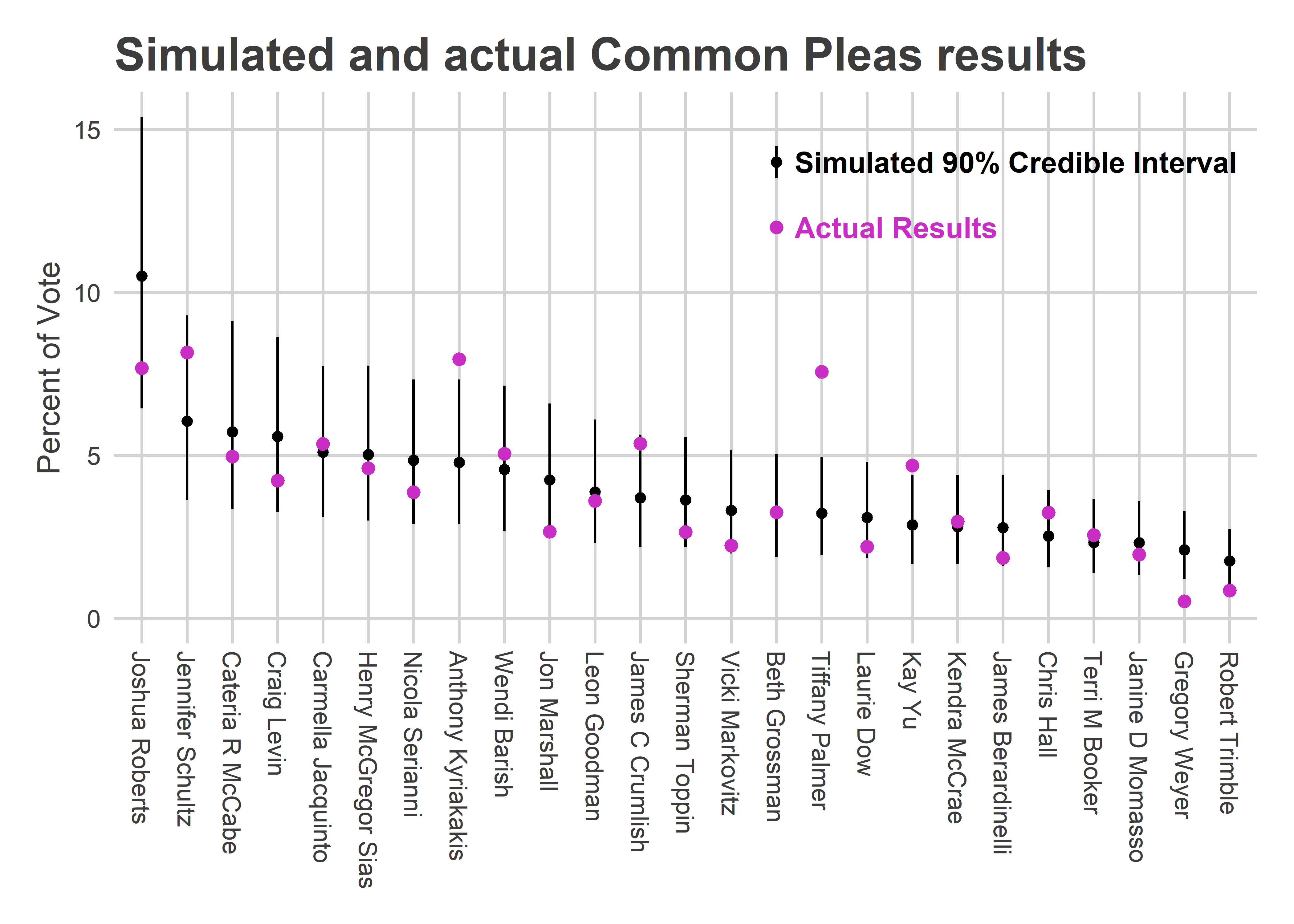 Kyriakakis and Palmer greatly exceeded the 90% credible range, and James Crumlish was at the top of it. Those three Highly Recommended candidates were all in the top four candidates who most overperformed my prediction (Kay Yu was the other).
Kyriakakis and Palmer greatly exceeded the 90% credible range, and James Crumlish was at the top of it. Those three Highly Recommended candidates were all in the top four candidates who most overperformed my prediction (Kay Yu was the other).
I significantly underestimated the Highly Recommended candidates this time. But it wasn’t my fault! Two years ago, the Bar didn’t Highly Recommend anybody. Four years ago, they Highly Recommended three; they all won, but didn’t appear to receive any more votes given their ballot position than the regular Recommendeds. So it was reasonable coming into this election to think that High Recommendations were just like regular ones.
The map of the winners’ votes makes it even clearer how each won.
View code
library(sf)
divs <- st_read("../../data/gis/2019/Political_Divisions.shp", quiet=TRUE) %>%
mutate(warddiv=paste0(substr(DIVISION_N, 1, 2), "-", substr(DIVISION_N, 3, 4)))
df_cp <- df_cp %>%
group_by(warddiv) %>%
mutate(pvote = Vote_Count/sum(Vote_Count)) %>%
left_join(cp_overall, by=c("candidate"), suffix=c("",".y")) %>%
group_by()
div_cp <- divs %>%
left_join(df_cp)
winners <-cp_overall %>% arrange(desc(pvote)) %>% with(candidate[1:6])
ggplot(
div_cp %>%
filter(candidate %in% winners) %>%
mutate(candidate = factor(candidate, levels=winners))
) +
geom_sf(aes(fill=pmin(100*pvote, 18)), color=NA) +
facet_wrap(~candidate)+
theme_map_sixtysix() %+replace% theme(legend.position = "right") +
scale_fill_viridis_c(
"Percent of Vote",
labels=function(x) paste0(x, "%", ifelse(x>=18,"+",""))
) +
ggtitle("Common Pleas winners' results")
Schultz won across the board: a telltale sign of the top ballot position. Roberts and Jacquinto won on the back of the DCC endorsements (with Roberts’s votes being super-charged by the second ballot position).
Crumlish did oddly well in the 50th and 10th wards in the Northwest (that nub of green at the top center). Those wards have powerful endorsements, and he wasn’t DCC endorsed. But it turns out he was in fact endorsed there. Here’s an image submitted to Max Marin’s #phillyballots collection:
View code
knitr::include_graphics("ward_50_endorsements.jpg_large")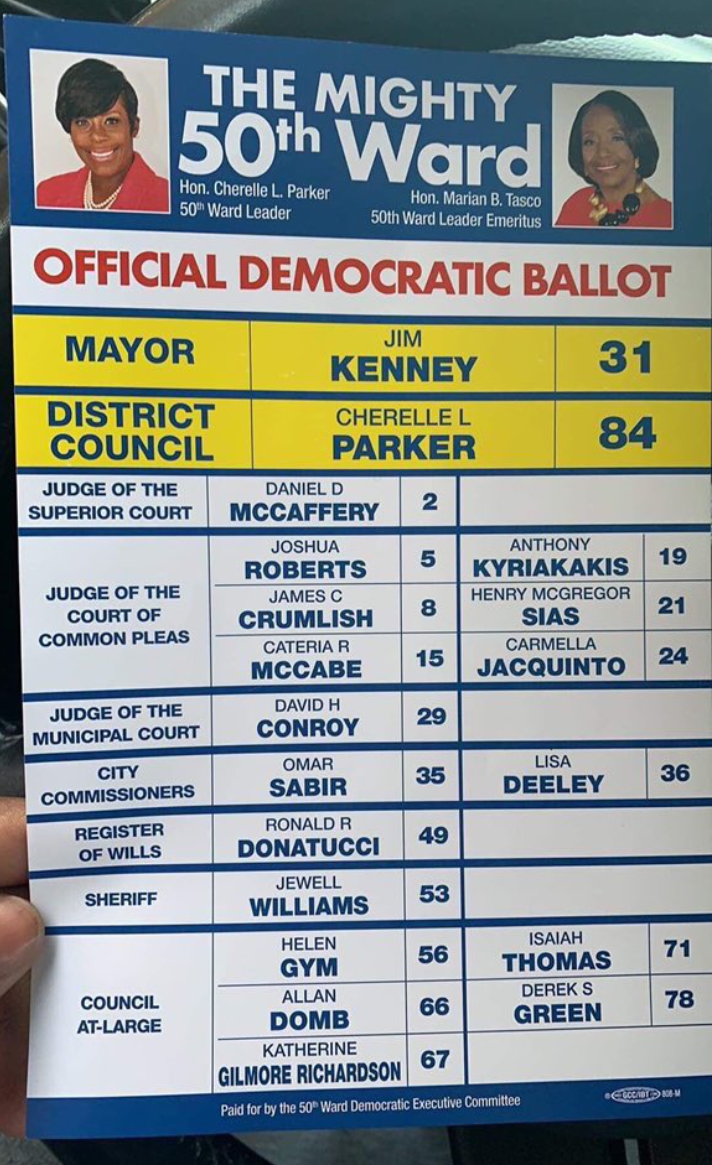
Kyriakakis and Palmer won with the wealthier wards (Center City and its ring, and Mount Airy/Chestnut Hill). This is where we’d expect the Bar Association’s Recommendations to matter most.
Have we done away with unqualified judges? Probably not.
All six of our winners were Recommended by the bar. This is a big improvement from the last two elections, which had three Not Recommended winners each.
But largely, that was luck. There was only one Not Recommended candidate in the first two columns of the of the ballot. Looking at the scatterplot above, the election went basically as predicted, except for the Highly Recommended dominance of Kyriakakis and Palmer. But nothing else has changed; especially the fact that a Not Recommended candidate at the top of the first ballot would probably have won.
How did the Highly Recommended Candidates win?
There are three reasons Highly Recommended candidates might have romped:
The High Recommendations themselves directly cause the win.
The High Recommendations made other causes easier to get (money, ward endorsements, buzz). These are called “mediators”.
The High Recommendations were in response to other traits of the candidates, and they would have won anyway. We call this “selection” or “omitted variable bias”.
Let’s lay out some evidence for each (out of order).
First, the evidence for mediating factors. Notice that having a High Recommendation was not sufficient for overperforming. Kyriakakis and Palmer did overperform, but Crumlish and Hall didn’t. That also matches with the timing of the High Recommendations: Kyriakakis and Palmer got theirs early on, Palmer and Hall much later. [The Bar recommendations come in on a rolling basis, depending on when the candidate submits their application and the timing of the investigative committee.]
This suggests to me that Kyriakakis and Palmer had time to milk that recommendation for other endorsements and to gain momentum in fundraising to spend on wealthy-neighborhood advertising. The mechanism was not, as a counterexample, just people looking up who was Highly Recommended. Otherwise Hall and Crumlish would have done better.
Second, it may have been that the High Recommendation just responded to factors that would have made Kyriakakis and Palmer do better anyway. Here are the results for Kay Yu, who also overperformed what I predicted. Her map looks a lot like theirs, maximizing the vote in Center City and its ring:
View code
ggplot(
div_cp %>%
filter(candidate == "Yu, K")
) +
geom_sf(aes(fill=pmin(100*pvote, 18)), color=NA) +
theme_map_sixtysix() +
scale_fill_viridis_c(
"Percent of Vote",
labels=function(x) paste0(x, "%", ifelse(x>=18,"+",""))
) +
expand_limits(fill=18)+
ggtitle("Kay Yu's Results")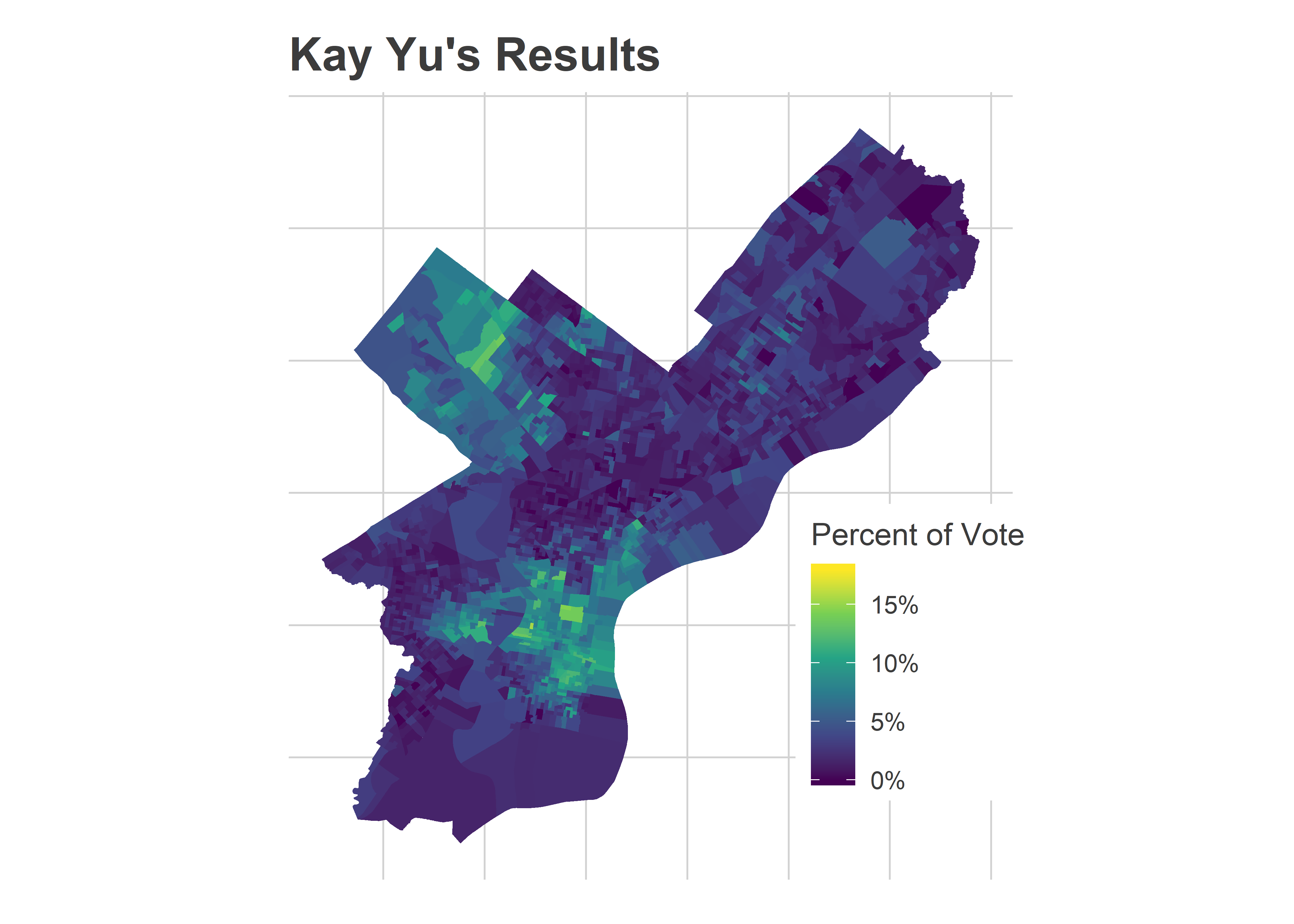
Yu presumably exploited the same strategies as Palmer, and Yu’s map might be what Palmer’s map would have looked like without the High Recommendation: a surprisingly strong showing that just falls short.
Finally, what is the direct effect of being Highly Recommended? How many people look that up before entering the booth, or grab the Inquirer, which listed the results? I don’t have a good way to know that, to disentangle that from the mediating, indirect pathways. And frankly, the winners probably don’t care whether their wins came from direct or mediating pathways, a win’s a win.
But that does lead me to…
The effect of Sample Ballots, Part 2
Two years ago, I partnered with the Bar Association to measure the effect of handing out their recommendations at polling places. This year, we decided not to randomize, but they still sent out nearly 100 volunteers to hand out recommendations outside of polling places. The Bar targeted polling places with high turnout, and allowed volunteers to self-select.
These are the flyers:
View code
knitr::include_graphics("PBA-Flyer-6.PNG")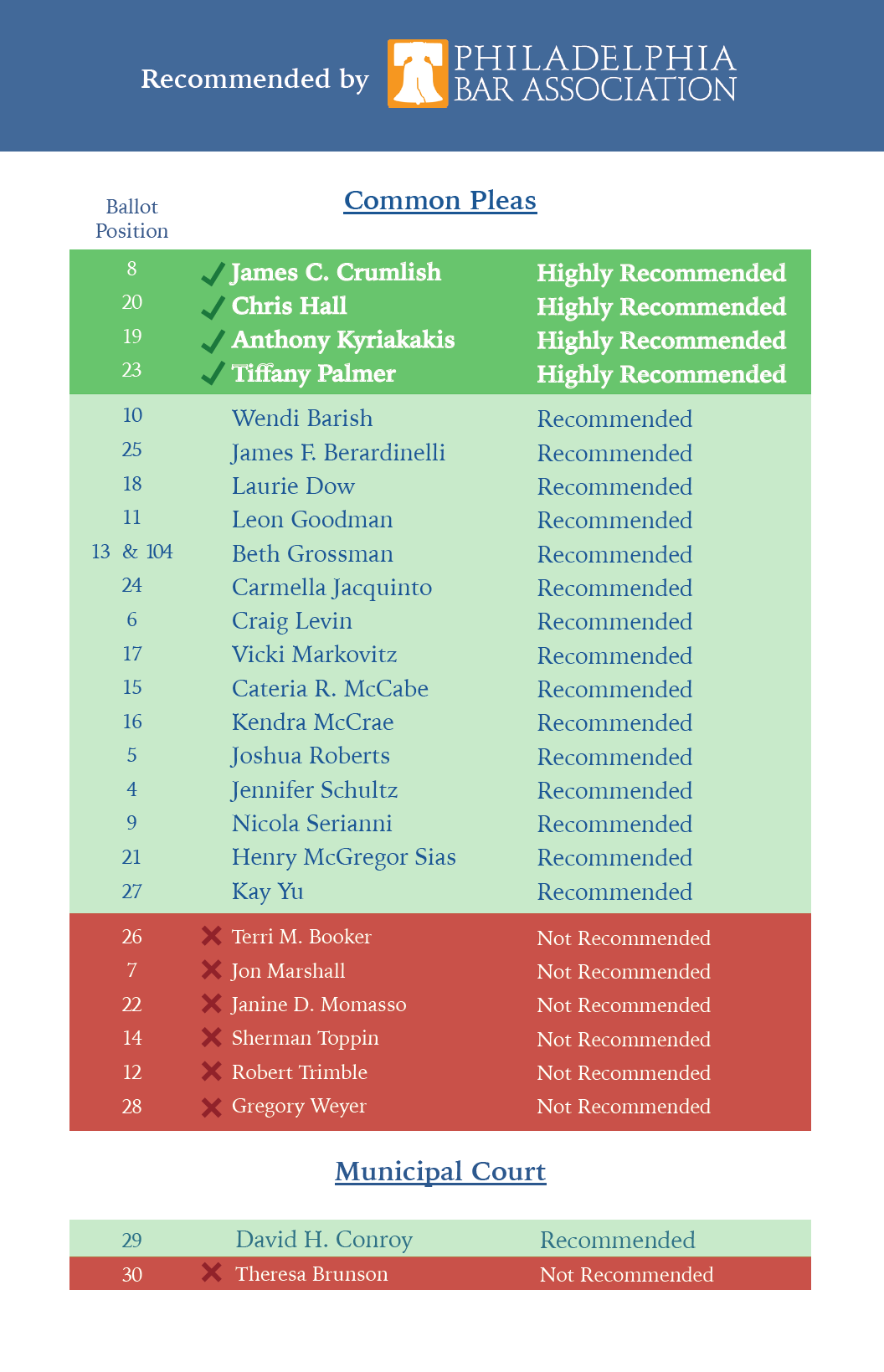 The flyer is more aggressive than two years ago, with some serious UX design. How much effect did it have? The folks at the Bar sent me their assignments, so let’s dig in.
The flyer is more aggressive than two years ago, with some serious UX design. How much effect did it have? The folks at the Bar sent me their assignments, so let’s dig in.
This analysis is more challenging than two years ago because we didn’t randomize polling place assignments. We might worry, for example, that the Bar Association’s volunteers would want to go close to their houses, and that those houses would be in places where the Highly Recommended candidates would already do well. Did that happen?
View code
vols <- read_csv("../../data/common_pleas/bar_assignments_2019.csv")
polling_places_to_divs <- read_csv("../../data/common_pleas/2019_Primary_Polling_Places.csv")
names(vols) <- tolower(names(vols))
names(polling_places_to_divs) <- tolower(names(polling_places_to_divs))
polling_places <- polling_places_to_divs %>% select(location, address) %>%
unique %>%
mutate(place_id = 1:n())
polling_places_to_divs <- polling_places_to_divs %>%
mutate(warddiv = sprintf("%02d-%02d", ward, division)) %>%
left_join(polling_places)
divs <- st_read("../../data/gis/2019/Political_Divisions.shp",quiet=TRUE) %>% st_transform(2272)
polling_places_sf <- divs %>%
mutate(warddiv = paste0(substr(DIVISION_N, 1, 2), "-", substr(DIVISION_N,3,4))) %>%
left_join(polling_places_to_divs) %>%
group_by(place_id) %>%
summarise(geometry = st_union(geometry))
vols_to_divs <- vols %>%
left_join(polling_places_to_divs)
if(any(is.na(vols_to_divs$ward))) stop("Missing Polling Place")
polling_places <- polling_places %>%
left_join(vols %>% select(location, address, shift) %>% mutate(has_vol=TRUE)) %>%
mutate(has_vol=ifelse(is.na(has_vol), FALSE, has_vol))
polling_places <- polling_places %>% left_join(polling_places_sf)
ggplot(polling_places) +
geom_sf(aes(fill = has_vol), color="grey78") +
scale_fill_manual(values=c("TRUE"=light_purple, "FALSE"="grey70"), guide=FALSE) +
theme_map_sixtysix() +
ggtitle("Where Bar volunteers went")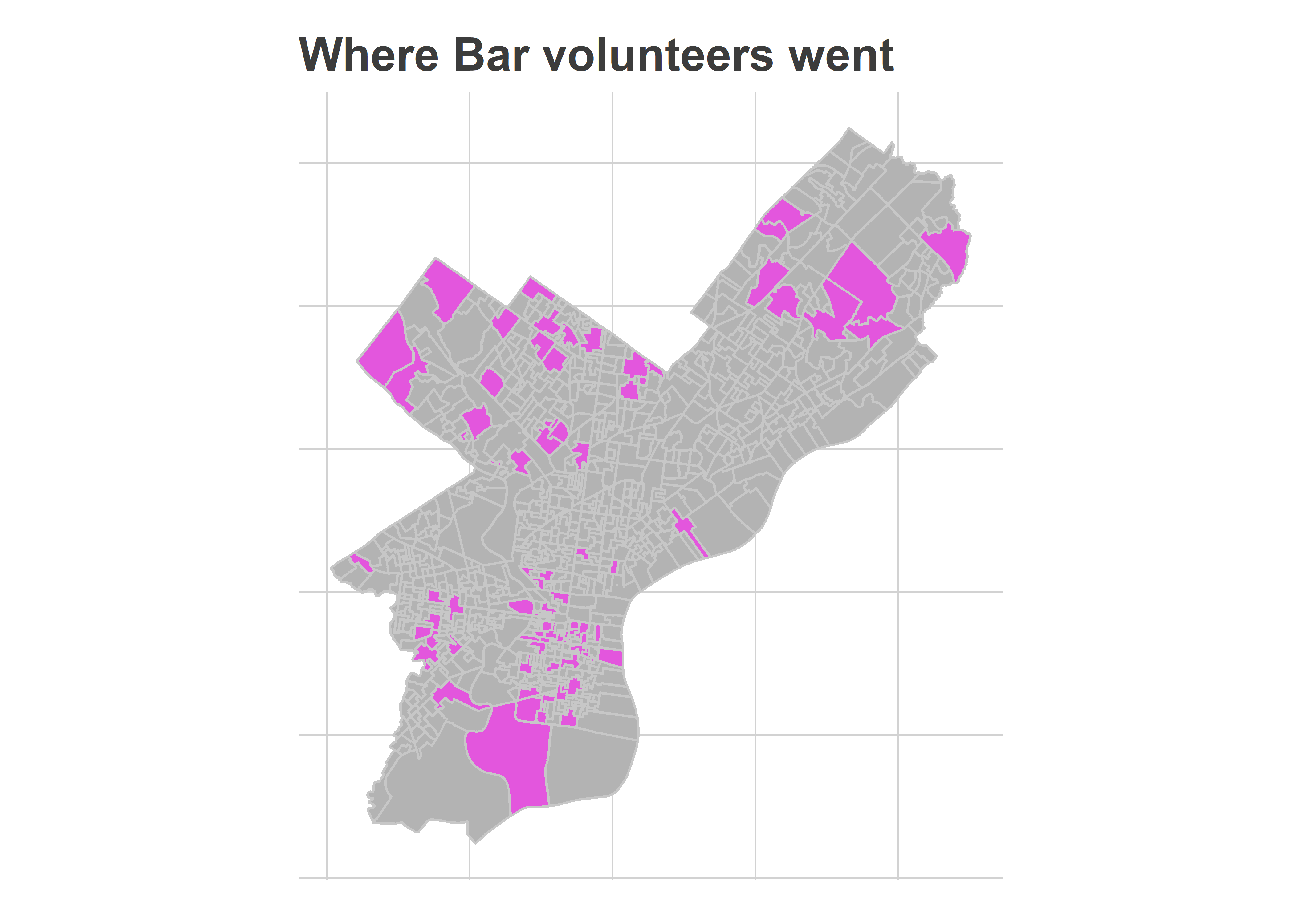
Yes and no. It’s not exactly a representative sample (vast sections of North Philly and the lower Northeast are missing), but it’s also not entirely Center City and its ring, which I worried. It was in the high-income wards that two years ago we found the lowest effect, because voters were already voting for Recommended candidates.
The divisions where they went were slightly non-representative: Highly Recommended candidates received 6.3% of the votes in Divisions that neighbored the volunteers, compared to 6.0% citywide. But that’s smaller than I might have worried.
View code
df_cp_pp <- df_cp %>%
left_join(polling_places_to_divs %>% select(warddiv, place_id)) %>%
group_by(candidate, place_id) %>%
summarise(votes = sum(Vote_Count))
neighbors <- st_intersection(
polling_places_sf,
polling_places_sf %>% rename(place_id2 = place_id)
) %>%
filter(place_id != place_id2)
neighbors <- neighbors %>%
mutate(geometry_type = st_geometry_type(geometry)) %>%
filter(!geometry_type %in% c("POINT", "MULTIPOINT")) %>%
as.data.frame %>% select(place_id, place_id2)
df_neighbor <- neighbors %>%
left_join(
polling_places %>% select(place_id, has_vol),
by = c("place_id2" = "place_id")
) %>%
rename(nb_has_vol = has_vol) %>%
left_join(df_cp_pp, by=c("place_id2"="place_id")) %>%
group_by(place_id, candidate) %>%
summarise(
votes_neighbor = sum(votes),
neighbors=c(list(place_id2)),
votes_neighbor_novol = sum(votes * !nb_has_vol)
) %>%
group_by(place_id) %>%
mutate(
# pvote_neighbor = votes_neighbor / sum(votes_neighbor),
pvote_neighbor_novol = votes_neighbor_novol / sum(votes_neighbor_novol)
)
df_neighbor <- df_neighbor %>%
left_join(df_cp_pp) %>%
group_by(place_id) %>%
mutate(pvote = votes/sum(votes))
df_neighbor <- df_neighbor %>%
left_join(polling_places %>% as.data.frame() %>% select(place_id, has_vol, shift))
df_neighbor <- df_neighbor %>% left_join(ballot)
## Neighbor votes, for number above
test_summary <- df_neighbor %>%
filter(has_vol) %>%
group_by(candidate, philacommrec) %>%
summarise(votes = sum(votes)) %>%
group_by() %>%
mutate(pvote = votes/ sum(votes)) %>%
group_by(philacommrec) %>%
summarise(`% Vote in volunteer divisions` = 100*mean(pvote))
control_summary <- df_neighbor %>%
filter(has_vol) %>%
group_by(candidate, philacommrec) %>%
summarise(votes = sum(pvote_neighbor_novol)) %>%
group_by() %>%
mutate(pvote = votes/ sum(votes)) %>%
group_by(philacommrec) %>%
summarise(`% Vote in neighboring divisions` = 100*mean(pvote))
overall_summary <- df_cp %>%
group_by(candidate, philacommrec) %>%
summarise(votes = sum(Vote_Count)) %>%
group_by() %>%
mutate(pvote = votes/ sum(votes)) %>%
group_by(philacommrec) %>%
summarise(`% Vote citywide` = 100*mean(pvote))
knitr::kable(
test_summary %>%
left_join(control_summary) %>%
left_join(overall_summary) %>%
mutate(
philacommrec = c("Not Recommended", "Recommended", "Highly Recommended")[philacommrec + 1]
) %>% rename("Recommendation" = philacommrec),
digits=1
)| Recommendation | % Vote in volunteer divisions | % Vote in neighboring divisions | % Vote citywide |
|---|---|---|---|
| Not Recommended | 1.7 | 1.8 | 1.9 |
| Recommended | 4.2 | 4.3 | 4.3 |
| Highly Recommended | 6.8 | 6.3 | 6.0 |
What was the effect of those volunteers? Let’s compare the highly-recommended candidates’ performance in volunteer divisions to their performance in neighboring divisions without volunteers.
View code
ggplot(
df_neighbor %>%
filter(philacommrec == 2 & has_vol),
aes(x = 100 * pvote_neighbor_novol, y=100*pvote)
) +
geom_point(
alpha = 0.5,
pch=16,
size=2,
color=strong_purple
) +
facet_wrap(~candidate) +
coord_fixed() +
geom_abline(slope=1, intercept=0) +
scale_x_continuous("Percent of vote in neighboring polling places") +
scale_y_continuous("Percent of vote in volunteer polling place") +
expand_limits(x=0, y=0) +
geom_smooth(method = lm, color="grey10")+
theme_sixtysix() +
ggtitle("Highly Recommended Candidates' performance\nwhere volunteers handed out recommendations")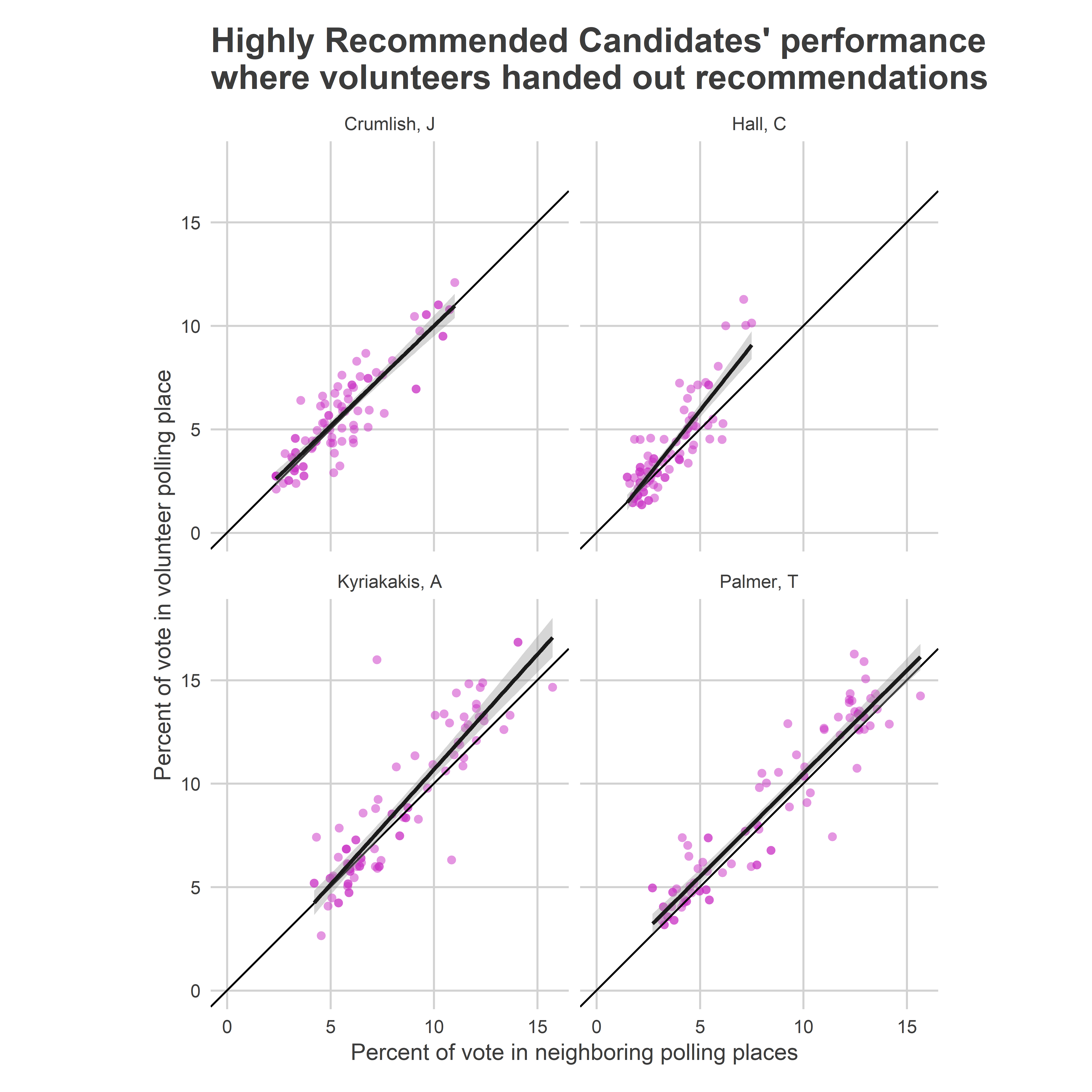
Each of the candidates did better in the polling places with volunteers than without them, with some evidence that the gap actually was bigger in places where they already were doing well.
On average, the difference between the percent of the vote earned in the volunteer divisions and the vote earned in neighboring divisions was half a percentage point for three of the candidates.
View code
df_neighbor %>%
filter(philacommrec == 2 & has_vol) %>%
group_by(candidate) %>%
summarise(
pvote = 100 * mean(pvote),
pvote_neighbor_novol = 100 * mean(pvote_neighbor_novol)
) %>%
mutate(diff = pvote - pvote_neighbor_novol) %>%
knitr::kable(
digits = 2,
col.names = c("Candidate", "% Vote in volunteer divisions", "% Vote in neighboring divisions", "Difference")
)| Candidate | % Vote in volunteer divisions | % Vote in neighboring divisions | Difference |
|---|---|---|---|
| Crumlish, J | 5.67 | 5.53 | 0.15 |
| Hall, C | 3.90 | 3.41 | 0.49 |
| Kyriakakis, A | 8.75 | 8.26 | 0.49 |
| Palmer, T | 8.56 | 8.07 | 0.50 |
We can use regression (with candidate random effects) to measure the average effect of volunteers. Notice that since the target is itself a paired difference, the candidate random effects represent heterogeneous volunteer treatment effects: listings may effect candidates differently.
On average, the volunteers increased the gap between Highly Recommended and Not Recommended candidates by 0.48 percentage points versus neighboring divisions.
View code
library(lme4)
lmer_fit <- lmer(
I(100 * (pvote - pvote_neighbor_novol)) ~ philacommrec + (1 | candidate),
df_neighbor %>%
filter(has_vol) %>%
mutate(philacommrec = as.character(philacommrec))
)
# summary(lmer_fit)
knitr::kable(
broom::tidy(lmer_fit) %>%
select(-group, -statistic) %>%
mutate(term = c(
"(Intercept)" = "Intercept (Effect of Volunteer on Not Recommended candidates)",
"philacommrec1" = "Additional effect on Recommended candidates",
"philacommrec2" = "Additional effect on Highly Recommended candidates",
"sd_(Intercept).candidate" = "S.D. of candidate effects",
"sd_Observation.Residual" = "S.D. of residual"
)),
digits=2,
col.name = c("Estimand", "Estimate", "Std. Error")
)| Estimand | Estimate | Std. Error |
|---|---|---|
| Intercept (Effect of Volunteer on Not Recommended candidates) | -0.07 | 0.09 |
| Additional effect on Recommended candidates | -0.01 | 0.11 |
| Additional effect on Highly Recommended candidates | 0.48 | 0.15 |
| S.D. of candidate effects | 0.20 | NA |
| S.D. of residual | 1.12 | NA |
Note that this estimate is the average effect among the divisions where the volunteers actually went. If they are not representative of the city as a whole, then this wouldn’t estimate the average effect if we were to send volunteers everywhere. Specifically, if we were to send volunteers everywhere, we might expect the overall average effect to be higher, since these were the divisions
Is this effect comparable to our estimate two years ago? It’s hard to say. First, in the last election there were no Highly Recommended candidates. We found that Recommended candidates received no benefit from volunteers in wealthy divisions, largely because residents were voting for them already. We replicated that finding this time, but actually did find a statistically significant boost for Highly Recommended candidates.
Second, the size of 0.5 percentage points likely would have been smaller two years ago, just because of the number of open spots. This year, voters were selecting 6 judges, in 2017 they elected 9. The raw math of that means that winners receive less of the vote, so the same treatments will probably have smaller raw effects. In this analysis, the 0.48 percentage point effect was 1/11th of the 5.3% it took to win. In 2017, listings increased the gap between Recommended and Not Recommended candidates by 0.41 percentage points, which was about 1/10th of 4.1% needed to win.
Lessons Learned
This year, we elected zero Not Recommended judges. That’s a big achievement, and important not to overlook.
Most of that was luck. If a Not Recommended candidate were to end up at the top of the first column, they would probably still win. Our system is still stupid.
But, the Highly Recommended candidates did better than we’ve seen before. That was probably mostly thanks to those candidates capitalizing on the recommendations: Palmer clearly maximized its impact in a way that Hall and even winner Crumlish didn’t.
Handing out listings had a larger effect this time than we saw two years ago, and may be part of a pathway to electing Highly Recommended judges, but more important is the myriad other ways that the Highly Recommended candidates have to capitalize on the Recommendations.
